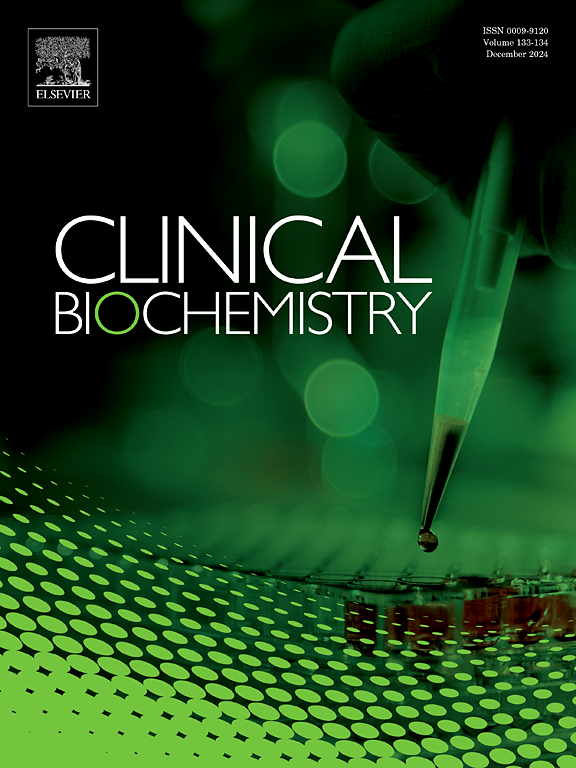Impact of lot-to-lot variation in absolute neutrophil count measured by a point-of-care device in patients receiving clozapine treatment
IF 2.1
3区 医学
Q2 MEDICAL LABORATORY TECHNOLOGY
引用次数: 0
Abstract
Background
Clozapine is indicated for patients with schizophrenia who are refractory to standard antipsychotic treatment. Due to risk of severe neutropenia, routine monitoring of absolute neutrophil count (ANC) is required. Image-based point-of-care devices for ANC measurement in capillary blood present an opportunity to reduce treatment barriers. The objective of this study was to evaluate the impact of lot-to-lot variation on ANC results using a point-of-care device (CSAN® Pronto™).
Methods
Retrospective patient data were extracted over a 13-month period. Results were classified for treatment safety per vendor as green (≥2.0 × 109/L), yellow (1.5–1.9 × 109/L), or red (<1.5 × 109/L). Distribution of ANC results, flagging rates, and rate and concordance of repeated results were determined. Patient comparisons between a laboratory analyzer (Sysmex XN-10) and Pronto were completed for ANC and WBC for each lot using linear regression and Bland-Altman statistics.
Results
522 patient results across four lots were reviewed. Percentage of results classified as yellow or red varied with lot (yellow: 4.4–10.1 %, red: 2.2–7.8 %). Results for 31 patients were repeated and a reclassification rate of 65 % was observed. Patient comparisons between Pronto and laboratory analyzer for ANC and WBC demonstrated good correlation (Pearson R: ≥0.970). A negative bias was observed for ANC relative to the laboratory that varied with lot (−0.80 to −0.53 × 109/L). The lot with the largest bias demonstrated the highest red alert rate and repeat rate in real-time patient data.
Conclusion
Our study combines patient-level data with method comparisons to highlight the impact of lot variation on results with potential consequences, including increased rates of repeated blood sampling. While point-of-care devices may facilitate lowering barriers for clozapine use, provider education and additional quality metrics are needed to inform testing.
在接受氯氮平治疗的患者中,由护理点装置测量的绝对中性粒细胞计数的批次对批次变化的影响
背景氯氮平适用于标准抗精神病药物治疗难治的精神分裂症患者。由于严重中性粒细胞减少的风险,需要常规监测绝对中性粒细胞计数(ANC)。用于毛细管血液中ANC测量的基于图像的护理点设备提供了减少治疗障碍的机会。本研究的目的是评估使用即时护理设备(CSAN®Pronto™)时批次对批次差异对ANC结果的影响。方法回顾性分析13个月的患者资料。结果将每个供应商的处理安全性分为绿色(≥2.0 × 109/L)、黄色(1.5 - 1.9 × 109/L)和红色(<1.5 × 109/L)。测定了ANC结果的分布、标记率以及重复结果的发生率和一致性。使用实验室分析仪(Sysmex XN-10)和Pronto对每个批次的ANC和WBC进行线性回归和Bland-Altman统计,完成患者比较。研究回顾了4个批次522例患者的结果。结果分类为黄色或红色的百分比随批次而变化(黄色:4.4 - 10.1%,红色:2.2 - 7.8%)。结果重复31例,重分率65%。Pronto与实验室分析仪检测ANC和WBC的患者比较显示出良好的相关性(Pearson R:≥0.970)。观察到ANC相对于实验室的负偏倚随批次而变化(- 0.80至- 0.53 × 109/L)。偏差最大的批次在实时患者数据中显示出最高的红色警报率和重复率。我们的研究结合了患者层面的数据和方法比较,以突出批次差异对结果的影响及其潜在后果,包括重复采血率的增加。虽然护理点设备可能有助于降低氯氮平使用的障碍,但需要提供者教育和额外的质量指标来为测试提供信息。
本文章由计算机程序翻译,如有差异,请以英文原文为准。
求助全文
约1分钟内获得全文
求助全文
来源期刊

Clinical biochemistry
医学-医学实验技术
CiteScore
5.10
自引率
0.00%
发文量
151
审稿时长
25 days
期刊介绍:
Clinical Biochemistry publishes articles relating to clinical chemistry, molecular biology and genetics, therapeutic drug monitoring and toxicology, laboratory immunology and laboratory medicine in general, with the focus on analytical and clinical investigation of laboratory tests in humans used for diagnosis, prognosis, treatment and therapy, and monitoring of disease.
 求助内容:
求助内容: 应助结果提醒方式:
应助结果提醒方式:


